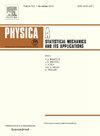Complexity of two-level systems
IF 2.8
3区 物理与天体物理
Q2 PHYSICS, MULTIDISCIPLINARY
Physica A: Statistical Mechanics and its Applications
Pub Date : 2025-01-22
DOI:10.1016/j.physa.2025.130389
引用次数: 0
Abstract
Complexity of two-level systems, e.g. spins, qubits, magnetic moments etc, are analyzed based on the so-called correlational entropy in the case of pure quantum systems and the thermal entropy in case of thermal equilibrium that are suitable quantities essentially free from basis dependence. The complexity is defined as the difference between the Shannon-entropy and the second order Rényi-entropy, where the latter is connected to the traditional participation measure or purity. It is shown that the system attains maximal complexity for special choice of control parameters, i.e. strength of disorder either in the presence of noise of the energy states or the presence of disorder in the off diagonal coupling. It is shown that such a noise or disorder dependence provides a basis free analysis and gives meaningful insights. We also look at similar entropic complexity of spins in thermal equilibrium for a paramagnet at finite temperature, and magnetic field , as well as the case of an Ising model in the mean-field approximation. As a result all examples provide important evidence that the investigation of the entropic complexity parameters help to get deeper understanding in the behavior of these systems.
求助全文
约1分钟内获得全文
求助全文
来源期刊
CiteScore
7.20
自引率
9.10%
发文量
852
审稿时长
6.6 months
期刊介绍:
Physica A: Statistical Mechanics and its Applications
Recognized by the European Physical Society
Physica A publishes research in the field of statistical mechanics and its applications.
Statistical mechanics sets out to explain the behaviour of macroscopic systems by studying the statistical properties of their microscopic constituents.
Applications of the techniques of statistical mechanics are widespread, and include: applications to physical systems such as solids, liquids and gases; applications to chemical and biological systems (colloids, interfaces, complex fluids, polymers and biopolymers, cell physics); and other interdisciplinary applications to for instance biological, economical and sociological systems.

 求助内容:
求助内容: 应助结果提醒方式:
应助结果提醒方式:


